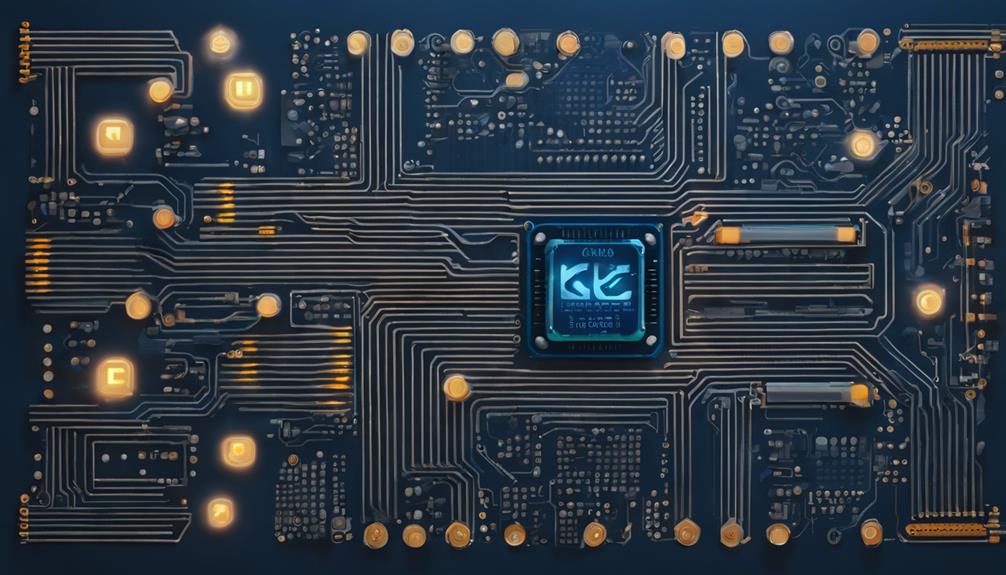Circuit simulation tools are essential for modern electronic design, allowing engineers to test and refine their designs in a virtual environment before prototyping. Top online circuit simulators include CircuitLab, EasyEDA, and Autodesk Circuits. For SPICE simulation, Ngspice, LTspice, and QUCS are popular choices. Analog circuit simulation tools like Multisim and OrCAD are also widely used. Additionally, digital circuit simulation software like Proteus and Multisim are available. With a wide range of tools and software available, designers can find the perfect solution for their specific needs, and discover more about the capabilities and features that each tool offers.
Key Takeaways
- Top circuit simulation tools include CircuitLab, EasyEDA, Autodesk Circuits, EveryCircuit, and DC/AC Virtual Lab for design and simulation needs.
- SPICE simulation software options include Ngspice, LTspice, QUCS, Xyce, and SPICE software for advanced circuit analysis.
- Analog circuit simulation tools such as Multisim, OrCAD, CST, HFSS, and Proteus offer specialized features for complex circuit designs.
- Digital circuit simulation software like Proteus, Multisim, and OrCAD enable designers to test and verify digital circuits efficiently.
- Open-source simulation alternatives like OpenCircuits.io, Antares, Wokwi Simulator for Arduino, and ESP32 Simulator provide cost-effective design solutions.
Best Online Circuit Simulators
Among the numerous online circuit simulators available, five popular options stand out for their unique features and user-friendly interfaces: CircuitLab, EasyEDA, Autodesk Circuits, EveryCircuit, and DC/AC Virtual Lab, as well as Tina Cloud. These online circuit simulators have become essential tools for engineers, students, and hobbyists alike, offering a convenient and accessible way to design, test, and analyze electronic circuits.
CircuitLab and EasyEDA are renowned for their ease of use and extensive component libraries, making them ideal for rapid prototyping and circuit design. Autodesk Circuits is a top choice for Arduino enthusiasts, allowing for seamless simulation of Arduino circuits.
EveryCircuit takes simulation to the next level with its dynamic, animated representations of circuit parameters. DC/AC Virtual Lab provides a visually stunning experience with realistic component graphics. Tina Cloud, on the other hand, offers unparalleled versatility, capable of analyzing analog, digital, and MCU circuits.
These online circuit simulators have revolutionized the way we approach circuit design and simulation, providing a powerful platform for innovation and discovery.
Top SPICE Simulation Software

SPICE simulation software, renowned for its unparalleled accuracy and versatility in handling complex circuits, has spawned a plethora of specialized tools that cater to the specific needs of engineers and researchers. These tools excel in providing detailed timing analysis for intricate circuits, leveraging SPICE's strengths in this area.
| Tool | Key Feature | Application |
|---|---|---|
| Ngspice | Advanced modeling capabilities | Analog and digital circuit simulation |
| LTspice | High-performance simulation | Power electronics and electromagnetics |
| QUCS | Graphical interface for ease of use | RF and microwave circuit design |
| Xyce | High-fidelity simulation | High-frequency and high-power applications |
SPICE simulation software is particularly well-suited for timing analysis, thanks to its simplified active component models, which enhance its efficiency in handling complex circuits. By leveraging these specialized tools, engineers and researchers can tap into the full potential of SPICE simulation, achieving accurate results and streamlining their design process.
Analog Circuit Simulation Tools

When it comes to analog circuit simulation, the choice of software can greatly impact the accuracy and efficiency of circuit analysis.
Effective analog circuit simulation tools should possess robust circuit analysis software capabilities, enabling users to accurately model and simulate complex analog circuits.
Additionally, device modeling capabilities are also essential, as they allow users to create accurate models of devices and components, ensuring reliable simulation results.
Circuit Analysis Software
Analog circuit simulation tools form the backbone of circuit analysis software, providing a thorough platform for designers to model, analyze, and optimize their analog circuit designs. These tools are essential for guaranteeing the reliability and performance of analog circuits in various applications.
Multisim is a recommended tool for simulating analog circuits, offering in-depth analysis capabilities that enable designers to thoroughly test and refine their designs. OrCAD software provides a versatile platform for various types of circuit simulations, including analog and digital circuits, allowing designers to work efficiently across multiple domains.
When it comes to high-frequency simulations, especially for microwave frequencies, tools like CST and HFSS are best suited, thanks to their 3D EM solving capabilities. By leveraging these circuit analysis software tools, designers can streamline their design process, reduce errors, and accelerate time-to-market.
Device Modeling Capabilities
Accurate device modeling is a critical aspect of analog circuit simulation, as it enables designers to create realistic representations of their circuit components and predict their behavior under various operating conditions. This is particularly important when working with analog and digital components, where precise modeling can make the distinction between successful design and failure.
| Software | Device Modeling Capabilities |
|---|---|
| Multisim | Extensive library of analog components, accurate modeling |
| Proteus | Robust analog simulation features, digital circuit simulation |
| Orcad | Versatile capabilities for simulating analog circuits |
| Proteus | Debugging tools, support for microcontroller models (MSP430, PIC) |
| CST/HFSS | 3D EM solvers for high-frequency simulations |
When selecting a circuit simulation tool, device modeling capabilities are essential for accurate results. Multisim, Proteus, and Orcad offer robust device modeling capabilities for analog circuit simulation, while Proteus excels in simulating microcontroller circuits. For high-frequency simulations, specialized tools like CST and HFSS are necessary. By choosing the right tool with suitable device modeling capabilities, designers can secure accurate and reliable results, saving time and resources in the design process.
Digital Circuit Simulation Software

When it comes to digital circuit simulation software, designers and engineers require tools that enable accurate and efficient analysis, design, and modeling of digital circuits.
The ideal digital circuit simulation software should offer a complete set of features, including circuit analysis tools, digital IC design capabilities, and electronic circuit modeling functionalities.
Circuit Analysis Tools
Among the diverse range of digital circuit simulation software available, Proteus, Multisim, and Orcad stand out as popular choices for circuit analysis, each offering a wide array of features and functionalities.
As circuit simulators, these tools enable designers to analyze and optimize their digital circuits with precision. Proteus, for instance, provides a thorough experience with debugging tools, while Multisim is recommended for analyzing analog circuits, offering a robust platform for simulation and analysis. Orcad simulation software, on the other hand, is versatile, incorporating features like PSPICE and PCB editor for a holistic simulation experience.
For more complex circuits, timing simulators are specialized, utilizing simpler active component models for efficient analysis. When high-frequency simulations are required, designers should consider wavelength and utilize tools like CST and HFSS for accurate microwave frequency analysis.
These circuit analysis tools are essential for designing and optimizing digital circuits, providing designers with the insights they need to create efficient and effective systems.
Digital IC Design
Digital IC design relies heavily on specialized software, such as Proteus and Multisim, which offer extensive simulation capabilities for designing and verifying digital integrated circuits. These tools enable designers to create, test, and refine their digital circuits in a virtual environment, reducing the need for physical prototypes and accelerating the design process.
When it comes to digital IC design, the following features are essential:
- Microcontroller simulation: Proteus is particularly well-suited for simulating microcontrollers, allowing designers to test and debug their designs.
- Robust simulation capabilities: Both Proteus and Multisim provide robust simulation experiences, enabling designers to test their digital circuits under various conditions.
- Debugging tools: Digital IC design software often includes debugging tools, which facilitate troubleshooting and error detection in microcontroller circuits.
- Analog and digital circuit analysis: While Multisim is commonly used for analog circuit analysis, it also supports digital circuit simulation, making it a versatile tool for digital IC design.
Electronic Circuit Modeling
Electronic circuit modeling, an essential aspect of digital circuit design, relies on specialized software that enables the simulation and analysis of digital circuits, facilitating the verification of their functionality and performance. This software, known as digital circuit simulation tools, focuses on modeling and simulating logic circuits, including gates, flip-flops, and counters.
These tools allow designers to test and analyze digital systems, identifying potential issues and verifying the correctness of digital designs before hardware implementation. Popular digital circuit simulation software includes Proteus, Logisim, and Xilinx ISE for FPGA designs.
By using a simulation program, designers can create a virtual environment to test and refine digital circuits, enhancing efficiency in the design process. This approach saves time and resources by eliminating the need for physical prototyping and reducing the risk of errors.
With digital circuit simulation tools, designers can confidently verify the functionality and performance of their digital designs, ensuring reliable and efficient electronic systems.
Microcontroller Simulation Platforms

Microcontroller simulation platforms play an essential role in the development of embedded systems, enabling designers to test and refine their designs in a virtual environment before prototyping. This approach allows for the identification and rectification of potential issues, reducing the risk of errors and ensuring a more efficient development process.
One popular simulation platform for microcontroller simulation is Proteus. This platform offers a range of benefits, including:
- Robust support for microcontroller simulation, allowing designers to thoroughly test and refine their designs.
- Specific tools for debugging and simulating circuits with microcontrollers, such as MSP430 and PIC.
- Comprehensive experience for simulating and testing microcontroller-based designs, providing a detailed understanding of the design's behavior.
- Enhanced debugging features, which streamline the development process for microcontroller circuits.
High-Frequency Simulation Solutions

While microcontroller simulation platforms focus on low-frequency circuit behavior, high-frequency simulation solutions are necessary to accurately model and analyze the behavior of circuits operating at microwave frequencies. In high-frequency simulations, it is essential to take into account the circuit's wavelength to achieve accurate results. This is because wavelength plays a critical role in determining the behavior of high-frequency circuits.
For effective high-frequency simulations, frequencies below 1/10th of a wavelength are typically used. This allows for accurate modeling of circuit behavior without introducing unnecessary complexities.
Advanced 3D EM solvers like CST and HFSS are ideal for high-frequency simulations, particularly at microwave frequencies. These simulators provide advanced tools for analyzing and optimizing high-frequency designs, enabling engineers to create high-performance circuits.
Electronic Circuit Analysis Software

In the domain of electronic circuit analysis software, the choice of simulation method and analysis features greatly impact the accuracy and efficiency of circuit design and verification.
The selection of circuit simulation methods, such as nodal analysis or modified nodal analysis, influences the precision of results, while features like component libraries, waveform analysis, and data visualization enhance the usability of analysis software.
When evaluating electronic circuit analysis software, it is crucial to take into account these factors to guarantee top performance and reliability.
Circuit Simulation Methods
Electronic circuit analysis software is an essential component of circuit simulation methods. It encompasses a range of tools and techniques that enable designers to accurately model and analyze complex electronic circuits. This allows designers to test and refine their designs without the need for physical prototyping, reducing development time and costs.
Circuit simulation methods can be categorized into several types:
- SPICE simulation: Widely regarded as the best for electronic circuit analysis, SPICE simulation software provides accurate modeling and analysis of complex circuits.
- Timing simulation: Timing simulators are lighter tools developed for analyzing complex circuit timing characteristics.
- Multisim simulation: Recommended for simulating analog circuits, Multisim offers a thorough simulation experience.
- High-frequency simulation: For high-frequency simulations, considerations of wavelength are important, with tools like CST and HFSS recommended for microwave frequencies.
These simulation methods rely on a robust simulation engine to accurately model and analyze complex electronic circuits. By leveraging these methods, designers can make sure that their designs meet performance and reliability requirements, reducing the risk of errors and costly rework.
Analysis Software Features
Circuit analysis software features a range of advanced capabilities that enable designers to accurately model and analyze complex electronic circuits, building upon the robust simulation methods discussed earlier. These simulation capabilities are vital for effective circuit design and optimization.
SPICE, a widely-used electronic circuit analysis software, offers advanced simulation capabilities for complex circuits. Its timing simulators are designed for intricate circuit timing analysis, leveraging simpler active component models for efficient timing analysis.
For analog circuit simulation, Multisim is a top recommendation, while Proteus excels in digital circuit design and simulation. Orcad simulation software stands out for its versatility, offering features like PSpice and a PCB editor for thorough circuit simulation experiences.
PCB Prototyping Simulation Tools

Frequently, designers rely on specialized tools to streamline the PCB prototyping process, leveraging simulation capabilities to validate their designs before physical production. This approach enables the identification and rectification of potential issues before investing in physical prototypes.
When it comes to PCB prototyping simulation tools, several options stand out for their unique features and capabilities. Some of the top tools in this category include:
- EasyEDA: Offers powerful schematic capture and circuit simulation capabilities.
- Autodesk Circuits: Provides a handy reference output design feature for PCB prototyping simulations.
- EveryCircuit: Offers pre-designed circuits that can be used for PCB prototyping simulations, ideal for beginners.
- CircuitLab: Allows users to export simulation results as CSV files, useful for analyzing data in PCB prototyping simulations.
These tools facilitate the PCB design process by providing designers with a virtual environment to test and refine their designs. By leveraging these simulation tools, designers can optimize their PCB designs, reduce the risk of errors, and accelerate the prototyping process.
Open Source Simulation Alternatives

Beyond commercial tools, open-source simulation alternatives have emerged, offering a cost-effective means to simulate and validate circuit designs. These alternatives provide a viable option for designers and engineers seeking to reduce costs without compromising on simulation capabilities.
| Open-Source Tool | Description |
|---|---|
| OpenCircuits.io | Free and open-source platform for circuit simulation |
| Antares | Versatile open-source circuit simulation software |
| Wokwi Simulator for Arduino | Browser-based tool for simulating Arduino projects |
| ESP32 Simulator | Developing platform for simulating ESP32 circuits |
Open-source simulation alternatives offer a range of benefits, including cost-effectiveness, flexibility, and community-driven development. These tools cater to various simulation needs, from circuit design to microcontroller-based projects. By leveraging open-source simulation alternatives, designers and engineers can optimize their design workflow and reduce costs associated with commercial tools. With the rise of open-source simulation alternatives, designers and engineers now have more options than ever to simulate and validate their circuit designs.
Circuit Design and Simulation Apps

Several innovative circuit design and simulation apps have emerged, offering intuitive interfaces and rapid simulation capabilities to streamline the design process. These apps provide a range of features that enable efficient circuit creation, simulation, and analysis.
Some key benefits of these apps include:
- Rapid simulation: Analog and digital circuit simulations are completed in seconds, allowing for efficient design iterations.
- Easy circuit creation: Easy-to-use schematic editors enable quick circuit creation, with features like Smart Wires Technology for fast schematic building.
- Professional documentation: Users can access professional schematic PDFs, wiring diagrams, and plots for detailed analysis and documentation of their circuits.
- Convenience: With no installation required, users can launch these apps instantly with just one click, making them convenient for quick circuit prototyping.
Electronic Circuit Simulation Features

Electronic circuit simulation features in modern tools have evolved to provide an unprecedented level of accuracy, flexibility, and visualization capabilities, empowering engineers and designers to analyze and refine their designs with precision.
Advanced simulation engines, such as CircuitLab's proprietary Simulation Engine, enable accurate and detailed circuit analysis.
EasyEDA's powerful schematic capture and circuit simulator facilitate efficient design and simulation processes.
Online circuit simulation tools, like EveryCircuit, offer impressive animated representations of dynamic parameters, enhancing visualization of circuit operations.
Autodesk Circuits allows simulation of Arduino projects, catering to microcontroller enthusiasts and learners.
DC/AC Virtual Lab's realistic component graphics make it suitable for practical circuit simulation and educational purposes.
These cutting-edge features enable engineers to simulate, analyze, and refine their designs with precision, reducing the risk of errors and optimizing performance.
Advanced Circuit Simulation Capabilities

Building on the advanced features of modern circuit simulation tools, advanced circuit simulation capabilities have emerged as a cornerstone of efficient and accurate design refinement, exemplified by CircuitLab's proprietary Simulation Engine. This engine offers advanced simulations for complex circuit designs, handling simulations from simple resistors to intricate transistor-level circuits.
Some key features of advanced circuit simulation capabilities include:
- Facilitate simulation process, making it easy to analyze mixed-signal designs efficiently.
- Smart Wires Technology, enabling fast and accurate schematic building for advanced simulations.
- Presentation-Quality Schematics, ensuring professional outputs for in-depth analysis of complex circuits.
- Accurate simulations, providing the best electronic circuit simulation for design refinement.
These capabilities empower designers to refine their designs with precision, ensuring that their final products meet the highest standards of performance and reliability.
Popular Circuit Simulation Software

Circuit simulation software tools, such as LTspice, PSpice, and Multisim, have emerged as indispensable resources for designers and engineers, offering a robust platform for analyzing and refining complex circuit designs. These popular simulation software tools have become staples in academia and industry, providing advanced features for circuit analysis and design.
In addition to commercial options, open-source alternatives like QUCS and ngspice offer versatile simulation capabilities, catering to diverse project requirements. These tools support analog, digital, and mixed-signal simulations, ensuring thorough coverage of circuit design needs. Moreover, their compatibility with various operating systems enhances usability and accessibility, making them accessible to a broad user base.
The widespread adoption of these simulation software tools is a confirmation of their effectiveness in streamlining the design process. By leveraging these tools, designers and engineers can efficiently test and refine their designs, reducing the risk of errors and improving overall performance. As the demand for sophisticated electronic systems continues to grow, the importance of circuit simulation software tools will only continue to increase.
Frequently Asked Questions
Which Is the Best Software for Circuit Simulation?
The age-old question that has plagued engineers for centuries: which is the best software for circuit simulation?
The answer, much like the holy grail, remains elusive. However, in the field of circuit simulation, SPICE stands out as the gold standard, offering unparalleled accuracy and versatility.
For analog circuits, Multisim is a close second, while OrCAD provides a thorough simulation experience. Ultimately, the best software depends on the specific needs of your project.
Is LT Spice Free?
To address the inquiry, LTspice, a renowned circuit simulation software, is indeed free to use.
Developed by Linear Technology, this powerful tool offers a wide range of features for simulating complex circuits, analyzing waveforms, and performing AC analysis.
With its accuracy and reliability, LTspice is widely adopted in academia and industry, making it an ideal choice for professionals and students alike.
Is Circuitlab Simulator Free?
In the inquiry on CircuitLab Simulator's cost, it is important to mention that the platform offers a free version with limited simulation capabilities, restricting users to 5 components per circuit.
Importantly, this version is ad-free, ensuring an uninterrupted user experience.
While the free version has limitations, users can upgrade to the full-featured version with a one-time in-app purchase or subscribe for $16 per month for advanced simulation needs.
How Much Does Everycircuit Cost?
Regarding the cost of EveryCircuit, a one-time purchase option is available for $14.99, granting access to all features on all platforms permanently.
Alternatively, the free version allows limited simulation with up to 5 components per circuit, ad-free, providing a seamless experience.
Educators can also opt for a class license.
This affordable and flexible pricing structure caters to various user needs, making EveryCircuit an accessible and valuable circuit simulation tool.


